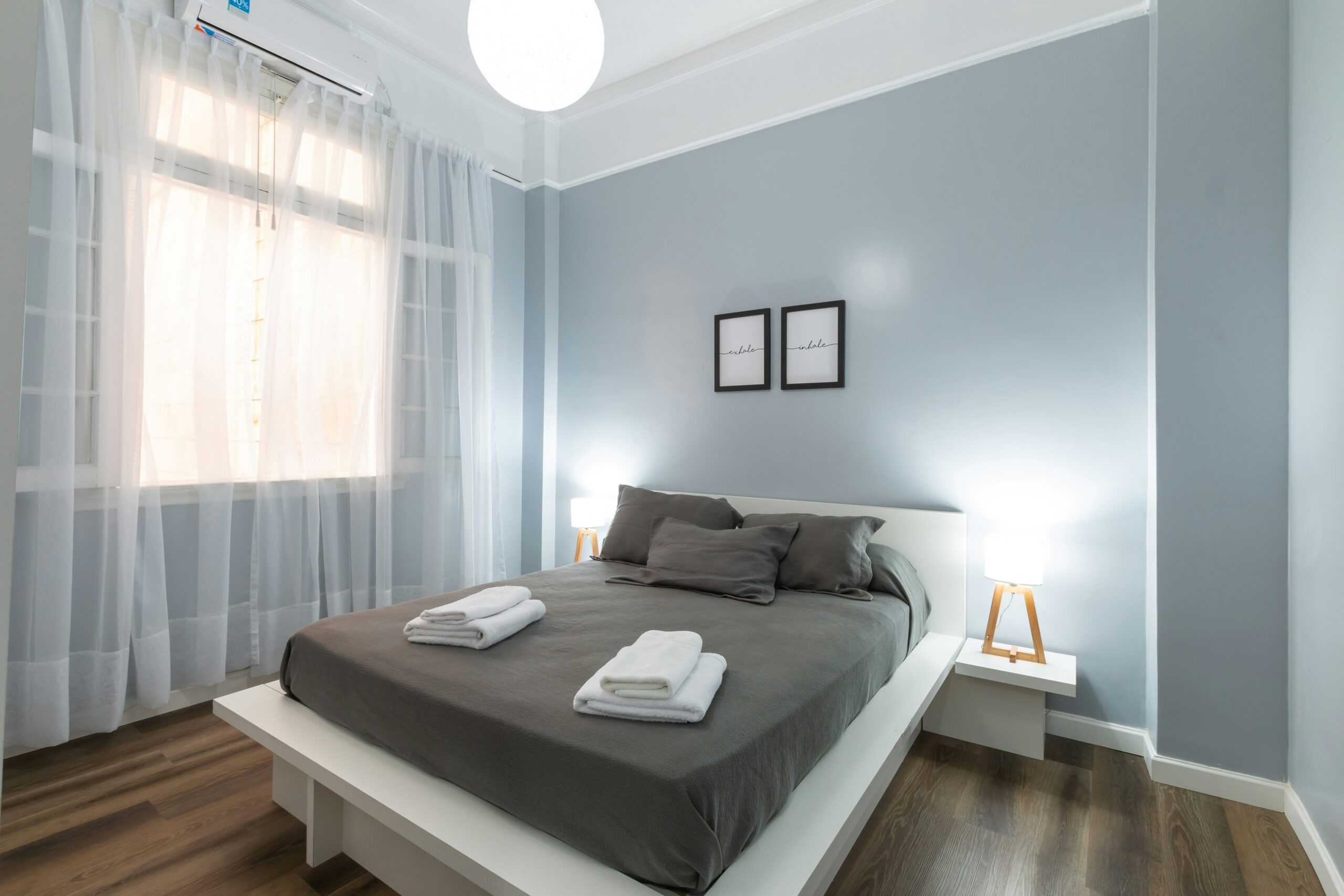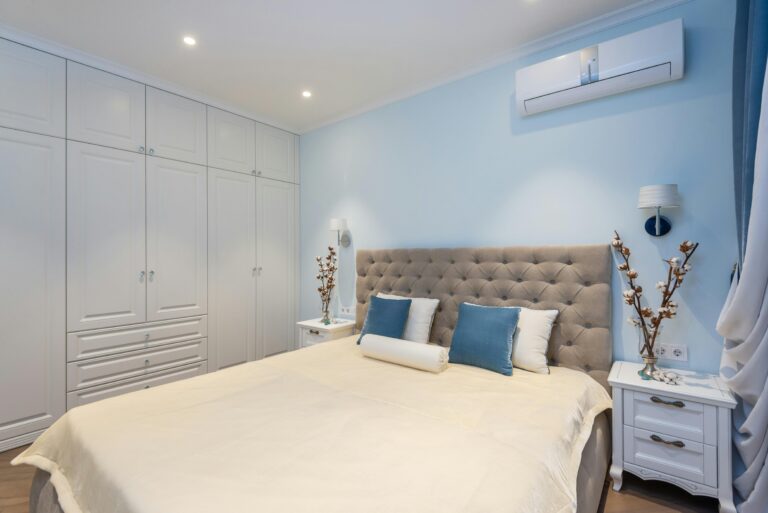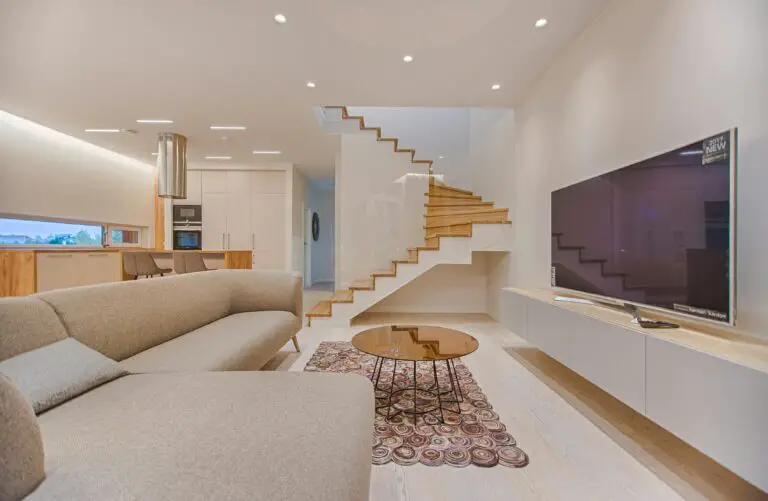In a world filled with constant noise and distractions, your bedroom should be an oasis of tranquillity and simplicity—a place where you can unwind, relax, and find peace. Minimalist bedroom design offers the perfect solution for achieving this coveted sense of serenity.
We’ll walk you through a series of expert tips for designing a minimalist bedroom retreat that fosters restful sleep and a peaceful atmosphere. From simplifying your layout to choosing calming color palettes and decluttering your space, you’ll discover the key principles of minimalist bedroom design.
I. Simplify the Bedroom Layout

Declutter and Remove Unnecessary Furniture
The journey to a minimalist bedroom retreat begins with decluttering and simplifying your space. Start by assessing your bedroom furniture and belongings. Are there pieces that serve no practical purpose or are seldom used? If so, consider removing them.
Minimalist bedroom design thrives on simplicity and functionality, so prioritize essential furniture items like your bed, nightstands, and a comfortable chair if space allows. Removing excess furniture not only declutters your room but also creates a sense of spaciousness and flow.
Opt for a Minimalist Bed Frame and Storage Solutions
The centrepiece of your bedroom is, of course, your bed. When selecting a bed frame, opt for a minimalist design with clean lines and a simple silhouette. Platform beds are an excellent choice for their sleek and unobtrusive appearance. To maximize space and minimize clutter, consider under-bed storage solutions.
Drawers or built-in storage compartments can keep your bedroom organized and free of excess items. The key is to keep your bedroom layout as open and uncluttered as possible to promote a sense of calm and serenity.
II. Choose a Calming Color Palette
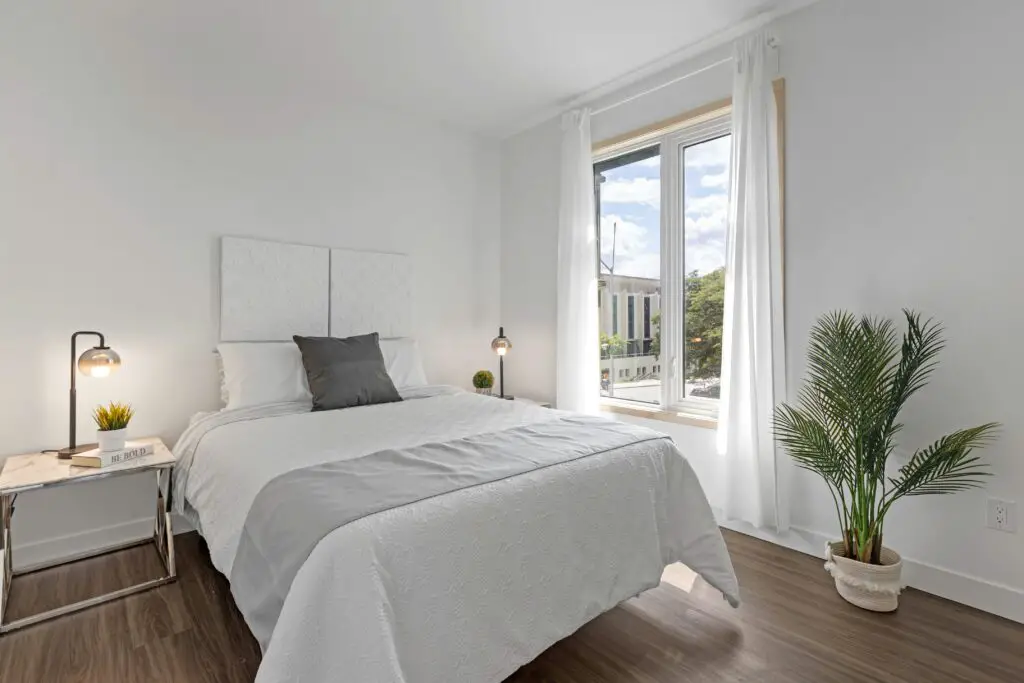
Select Neutral and Muted Colors
Minimalist bedroom design thrives on a limited color palette, often featuring neutral and muted tones. These colors evoke a sense of tranquility and simplicity, making them perfect for creating a peaceful retreat.
Shades of white, beige, soft gray, and muted pastels work exceptionally well in minimalist bedrooms. These colors are timeless and versatile, allowing you to create a serene backdrop that complements various design styles.
Introduce a Limited Color Scheme
While neutrals dominate minimalist bedroom design, you can introduce a limited color scheme to add depth and character to your space.
Select one or two accent colors that resonate with you and are in harmony with the overall aesthetic. These accents can appear in your bedding, decor items, or even a single wall, but remember to keep them understated. The goal is to create a calming and cohesive visual experience in your minimalist bedroom.
III. Minimalist Furniture and Decor
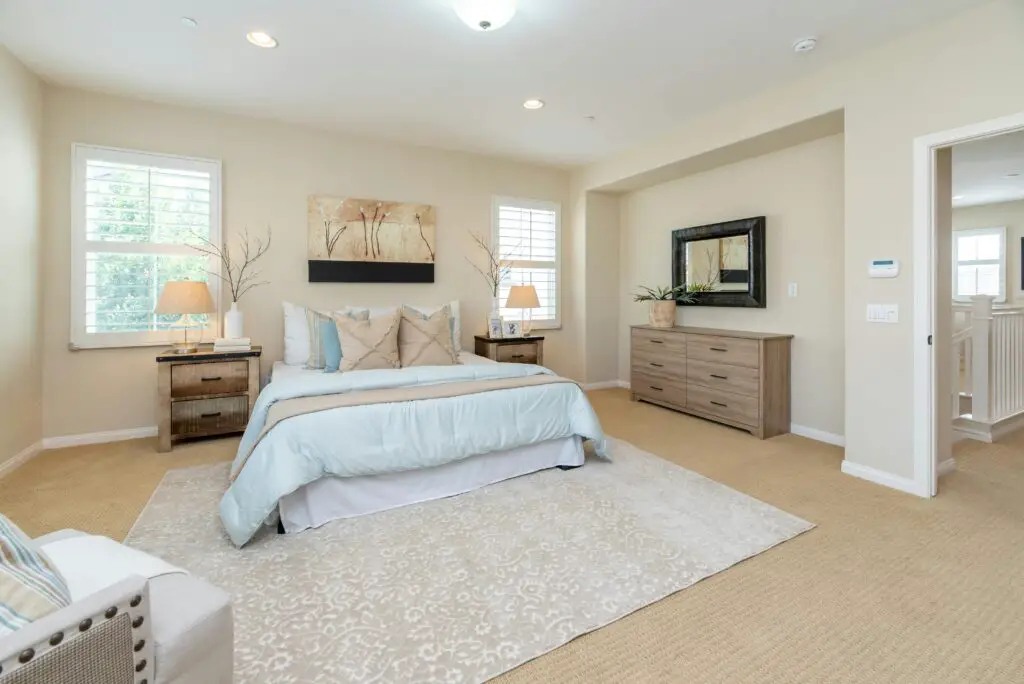
Select Functional and Essential Furniture Pieces
In a minimalist bedroom, each piece of furniture should serve a purpose and contribute to the overall functionality of the space. Consider streamlined and multifunctional furniture items. For example, choose a nightstand with built-in storage or a floating shelf instead of bulky dressers.
Your bed should be comfortable and supportive but also free from unnecessary embellishments. Look for minimalist bed frames with clean lines and minimalistic design elements.
Incorporate Multi-Purpose Furniture Items
Multifunctional furniture is a hallmark of minimalist design. Look for pieces that can serve multiple roles, such as a bed with under-bed storage or a desk that doubles as a vanity. These items not only save space but also contribute to the clean and uncluttered look of your bedroom. As you select furniture and decor, prioritize functionality and simplicity over ornate details.
IV. De-clutter and Organize
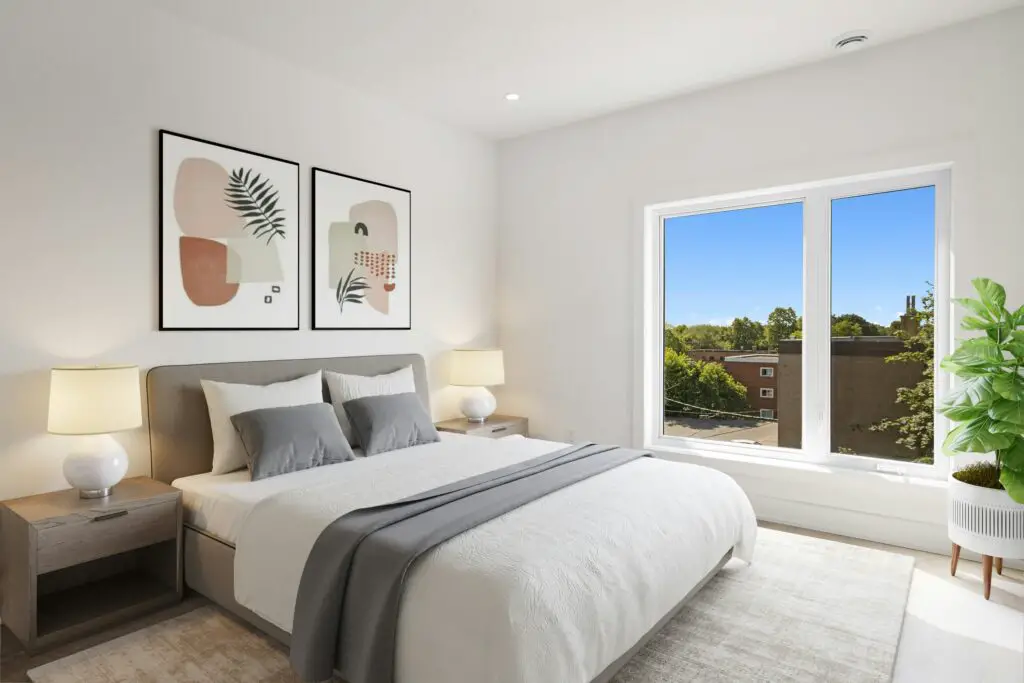
Implement Efficient Storage Solutions
Efficient storage is essential in a minimalist bedroom retreat. Embrace storage solutions that help you keep your belongings organized and out of sight. Consider built-in closet systems with plenty of shelves, drawers, and hanging space to keep clothing and accessories tidy.
Under-bed storage, floating shelves, and wall-mounted cabinets can also provide ample storage without compromising the room’s minimalist aesthetic.
Regularly Declutter and Reassess Possessions
Minimalism is not a one-time effort; it’s a way of life. Regularly declutter your bedroom and reassess your possessions. If you haven’t used an item in months or it doesn’t contribute to your sense of peace and serenity, consider parting with it.
Minimalist bedroom design encourages mindfulness and intentionality in your choices. By periodically evaluating your belongings, you can ensure that your bedroom remains a clutter-free and tranquil space.
Maintain a Clutter-Free and Serene Environment
Maintaining a clutter-free and serene bedroom environment requires ongoing effort and mindfulness. Establish a daily maintenance routine to keep your space tidy. Make your bed each morning, return items to their designated storage spots, and dust or wipe surfaces regularly. Resist the temptation to accumulate unnecessary items, and be vigilant about not letting clutter creep back into your retreat.
V. Texture and Materials
Introduce Texture Through Textiles and Materials
Minimalist bedrooms may have a limited color palette, but they can be rich in texture. To add warmth and depth to your space, introduce texture through textiles and materials. Consider a soft, plush rug under your feet when you wake up in the morning.
Choose high-quality bedding with a variety of textures, such as crisp cotton sheets, a cozy duvet, and textured throw pillows. Incorporate natural materials like wood and stone for furniture or decor items to create a tactile and inviting atmosphere.
Focus on Quality Over Quantity
In the world of minimalist bedroom design, quality should always take precedence over quantity. Invest in well-crafted and timeless furniture pieces that will stand the test of time.
When selecting textiles and materials, opt for high-quality fabrics and finishes that not only feel luxurious but also endure daily use. The minimalist aesthetic is about appreciating and highlighting the beauty of each element in your bedroom, so choose items that are built to last.
VI. Lighting Design
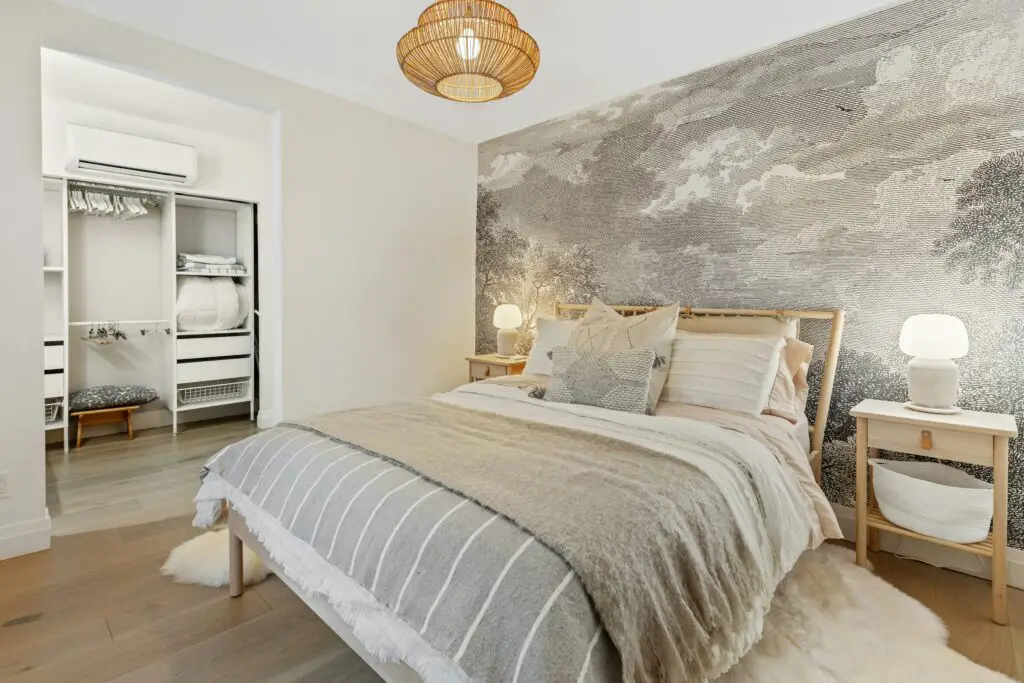
Opt for Soft and Indirect Lighting
Lighting plays a crucial role in creating the right ambiance in a minimalist bedroom retreat. Opt for soft and indirect lighting that casts a warm and inviting glow. Avoid harsh overhead lighting, and instead, consider wall sconces, pendant lights, or table lamps with adjustable settings. Soft, diffused light can create a cozy atmosphere, making your bedroom the perfect place to unwind after a long day.
Use Adjustable Lighting Fixtures for Versatility
Versatile lighting fixtures are a valuable addition to a minimalist bedroom. Choose fixtures with adjustable settings to tailor the lighting to your needs. Dimmer switches or smart lighting systems allow you to control the intensity and warmth of the light, perfect for creating different moods throughout the day.
VII. Mindful Art and Decor
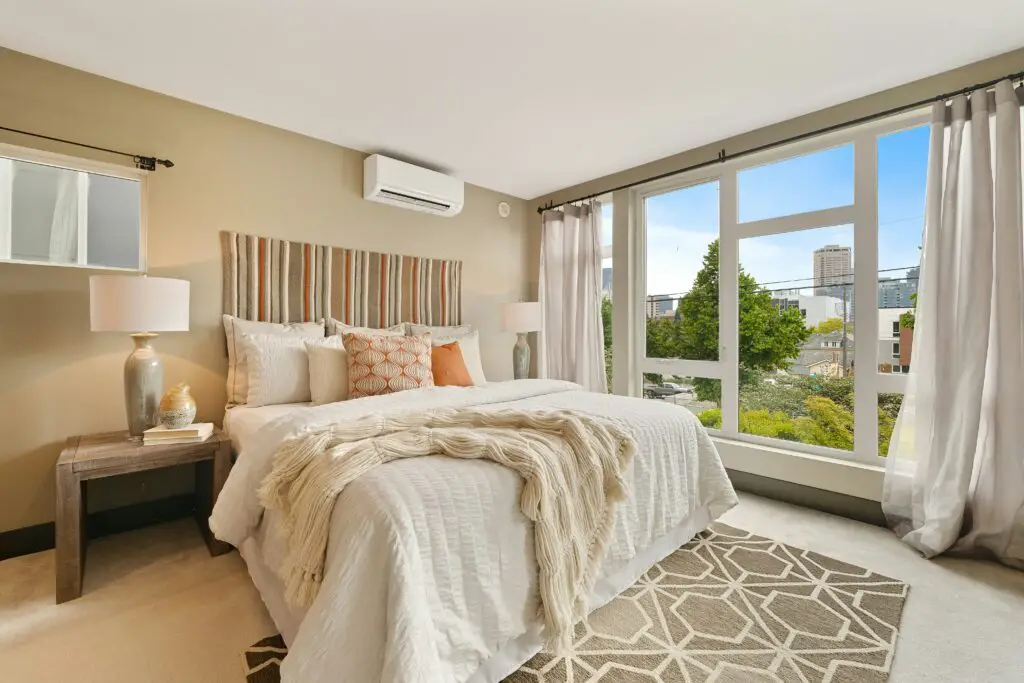
Display Meaningful and Minimal Art Pieces
Minimalist bedroom design doesn’t mean forgoing art and decor altogether. Instead, focus on displaying meaningful and minimal art pieces that contribute to the ambiance of your space. Choose artworks that resonate with you and evoke a sense of calm.
Consider framed photographs, abstract paintings, or sculptures that align with the minimalist aesthetic. The key is to select art that complements the overall design and fosters a serene atmosphere.
Consider the Principles of Negative Space
Negative space, or the intentional empty areas in your bedroom, is a fundamental aspect of minimalist design. Embrace the principles of negative space by leaving areas of your room unadorned.
Allow your walls, surfaces, and even floors to breathe. This not only highlights the simplicity of your bedroom but also creates a sense of serenity and balance. When arranging art and decor, be mindful of the spacing and placement, ensuring that each piece contributes to the overall harmony of the space.
VIII. Minimalist Bedroom Accessories

Choose a Few Well-Curated Accessories
While it’s essential to keep decor minimal in a minimalist bedroom, you can still incorporate a few well-curated accessories. Select items that align with the calming and serene vibe you want to create. For example, a single vase with fresh flowers, a decorative tray, or a carefully chosen sculpture can add a touch of personality without overwhelming the space.
Keep Surfaces Clear of Clutter
One hallmark of minimalist design is clear surfaces. Avoid cluttering your nightstands, dressers, or any available space with unnecessary items. Keep surfaces clear except for a few carefully selected accessories or essentials. This not only enhances the minimalist aesthetic but also promotes a sense of order and tranquility.
Incorporate Plants for a Touch of Nature
Bringing a touch of nature into your minimalist bedroom can add life and vibrancy to the space. Consider incorporating the best houseplants or succulents into your decor. Choose low-maintenance varieties that thrive in indoor environments. The presence of greenery not only contributes to the aesthetic but also promotes air quality and a sense of well-being.
IX. Maintain Serenity and Order
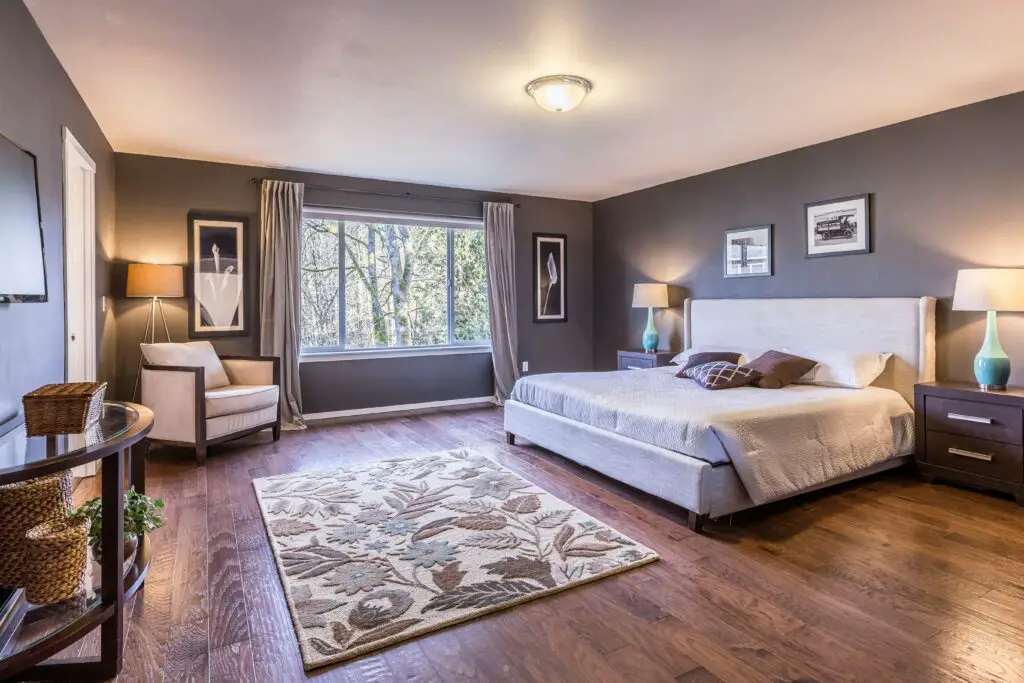
Establish a Daily Maintenance Routine
To maintain the serenity and order of your minimalist bedroom retreat, establish a daily maintenance routine. Make your bed each morning to create an immediate sense of tidiness. Put away any items that have been used during the day, such as clothing or reading materials. Wipe down surfaces and dust as needed to keep the space clean and inviting.
Create a Serene Bedtime Ritual
Incorporate a serene bedtime ritual to unwind and prepare for restful sleep. Disconnect from electronic devices at least an hour before bedtime to reduce distractions and promote relaxation. Consider practices such as meditation, gentle stretching, or reading a book to calm your mind. Your minimalist bedroom should serve as a sanctuary for rest, and a peaceful bedtime routine can help you achieve a restful night’s sleep.
Practice Mindfulness for a Peaceful Sleep
Minimalist bedroom design aligns with the principles of mindfulness. Embrace mindfulness in your nightly routine by focusing on the present moment and the sensations of your surroundings.
As you settle into your bed, pay attention to the feel of the sheets against your skin and the gentle rhythm of your breath. Mindfulness can help you let go of the day’s stress and worries, allowing you to enjoy a peaceful and restorative sleep in your minimalist retreat.
Conclusion
Designing a minimalist bedroom retreat is a journey toward simplicity, tranquility, and mindfulness. Simplifying your bedroom layout, choosing calming color palettes, selecting minimalist furniture and decor, decluttering and organizing your space, incorporating texture and materials, optimizing lighting design, displaying mindful art and decor, curating minimalist accessories, and practicing serenity and order, will help you create a haven of peace and relaxation in your home.
A minimalist bedroom isn’t just a design choice; it’s a lifestyle that promotes restful sleep, mental clarity, and a profound sense of well-being.
Frequently Asked Questions
1. How do you arrange a minimalist bedroom?
Arranging a minimalist bedroom involves simplifying the layout, choosing minimalistic furniture, selecting a calming color palette, and incorporating mindful decor. Focus on functionality, declutter regularly, and maintain serene surroundings for a minimalist bedroom retreat.
2. How do you make a cozy minimalist bedroom?
To make a cozy minimalist bedroom, prioritize comfort with high-quality bedding and textiles. Opt for soft, indirect lighting, incorporate warm materials like wood, and add a few well-curated accessories. Maintain a clutter-free and serene environment for ultimate coziness.
3. How do you create a minimalist interior design?
Creating a minimalist interior design involves decluttering, choosing a limited color palette, selecting functional furniture, and embracing simplicity. Focus on quality over quantity and prioritize serene and uncluttered spaces.
4. What does a minimalist bedroom look like?
A minimalist bedroom typically features a simplified layout with essential furniture, a calming color palette of neutrals and muted tones, and minimalistic decor. The space promotes tranquility, order, and a sense of spaciousness.
5. What is the best color for a minimalist bedroom?
The best colors for a minimalist bedroom are neutrals and muted tones such as white, beige, soft gray, and muted pastels. These colors create a calming and serene atmosphere in line with minimalist design principles.
6. What are the features of minimalist style?
Minimalist style is characterized by simplicity, functionality, and a focus on essential elements. It emphasizes clean lines, a limited color palette, uncluttered spaces, and an overall sense of tranquility and order.
7. What are the 5 most important features of minimalist architecture?
The five most important features of minimalist architecture are simplicity, clean lines, functional design, minimalistic materials, and a focus on space and light. Minimalist architecture prioritizes the essentials and promotes a sense of harmony and openness.
8. What are the three artistic qualities of minimalism?
The three artistic qualities of minimalism are simplicity, repetition, and the use of geometric shapes. Minimalist art often features clean and unadorned compositions that evoke a sense of purity and minimalism.
9. What makes a great minimalist design?
A great minimalist design is characterized by simplicity, functionality, and a focus on essential elements. It creates a sense of harmony, order, and tranquility while eliminating unnecessary embellishments and clutter.
10. What is the disadvantage of minimalist design?
One disadvantage of minimalist design is that it may feel too stark or cold for some individuals who prefer a more eclectic or traditional style. Additionally, achieving a minimalist look can be challenging, requiring careful curation and organization.
11. What are the problems with minimalist design?
Common problems with minimalist design include difficulty in maintaining clutter-free spaces, a potential lack of warmth, and challenges in creating a visually interesting environment. It may also be less suitable for those who enjoy collecting or displaying a wide variety of objects.
12. What are minimalist design standards?
Minimalist design standards emphasize simplicity, functionality, and a focus on essential elements. They prioritize clean lines, uncluttered spaces, and a limited color palette to create a sense of order, tranquility, and visual harmony.
